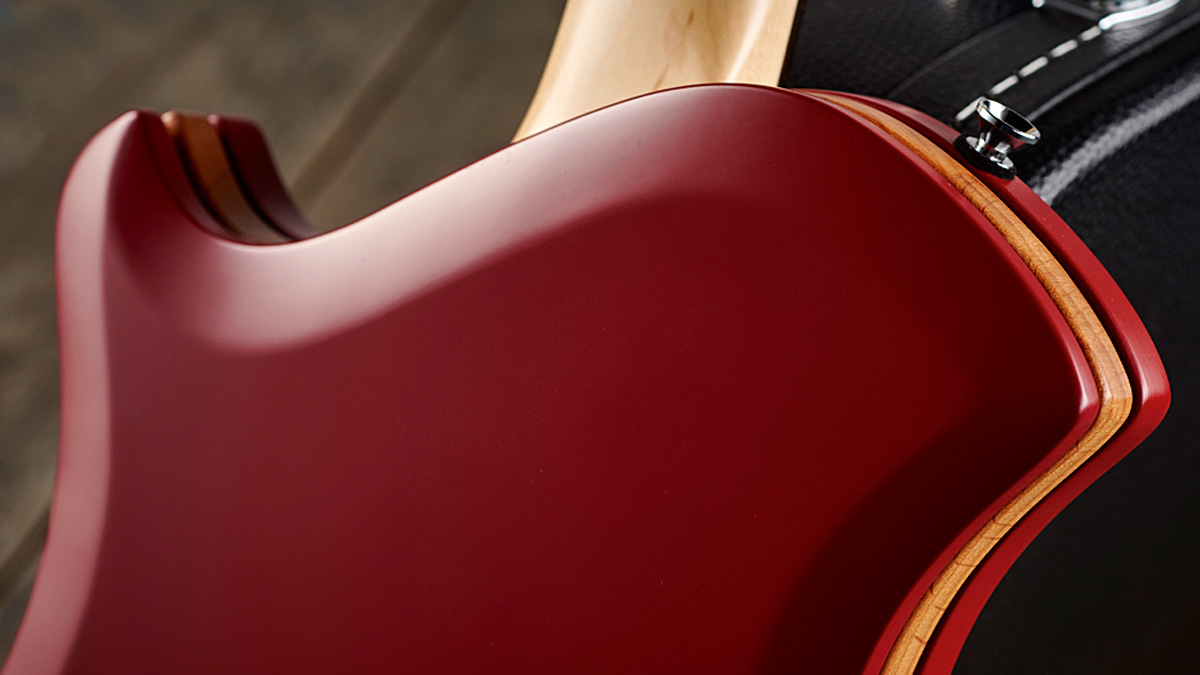MusicRadar Verdict
A hugely interesting design for the player and collector who appreciates the craft of the instrument and doesn't want yet another 'me-too' electric.
Pros
- +
More conventional vision; 'real world' price; more conventional sounds, too.
Cons
- -
It's a bit weighty; again, could feature more sounds.
MusicRadar's got your back

Relish Bloody Mary

Relish Bloody Mary
Today, we welcome Relish: the modernist vision of a carpenter-cum-industrial designer and marketing/sales specialist.
The recently reviewed Walnut Jane is the company's original vision. Mary is a different proposition in terms of price, but includes less of Jane's modernism in terms of material choice, although it pretty much includes the same hardware and pickups.
Both guitars use a 650mm (25.59-inch) scale length, the classical guitar standard and, of course, just 2mm longer than the classic Fender scale of 648mm. The necks are the same, too: Fender-like bolt-ons, albeit with a small three-a-side headstock that, perhaps surprisingly, doesn't offer completely straight string pull over the nut, like PRS or Music Man, for example.
With an intention not to use tropical hardwoods in its designs, Relish has nonetheless chosen a very rosewood- looking 254mm (10-inch) radius'd fingerboard that is actually a 'woven' bamboo - a first for us. Frets are stainless steel with notched tangs that sit over a thin edge binding - very tidy, very modern and impeccably crafted.
The nuts are graphite and beautifully shaped: a high level of detail is evident everywhere and there's not a hair out of place. Mary is more showy than Jane with a raised metallic logo, standard Schaller mini-tuners (not the 510 Gotohs used on Jane), and a less fettled nut that's perfectly functional nonetheless. It has open-hole truss rod access that might appear unfinished to some. It doesn't bother us.
The body shapes and construction are profoundly different, although they have a sibling similarity, with the upper shoulder of Mary creating, perhaps, a more conventional look that mirrors its construction. But we use the word 'conventional' lightly...
Mary swaps the beautiful curves of Jane's front and back with a flat-faced 'slab' construction of around 51mm thick compared with Jane's more bulbous 57mm depth. The front and thinner back are machined from what Relish calls 'high pressure veneers' - although it does look like MDF - while the centre core is alder, not aluminium.
Want all the hottest music and gear news, reviews, deals, features and more, direct to your inbox? Sign up here.
But the three layers have a gap between them and you can pull the back off and see the construction clearly. Seven magnets hold the back, but, importantly to the design, rubber O rings keep the parts separate.
The core is more solid than Jane's. It has cavities for the pickups and controls, with the same Emerson electronics and vintage-style paper-in-oil-cap - which is kind of ironic on such a modernist design - but you'll find conventional solder joints and there's no need for any battery power because the pickup selection is a three-way lever switch.
However, like Jane, there's no facility for coil-splits, which could have given us some more single-coil sounds via a modern five-way lever switch.
Sounds
Mary is a more conventional gal than Jane. The sustain is noticeable, but there's less 'wood' and a zingier response.
Strapped on, we find Mary is weightier and feels less ergonomic. Both necks play really nicely and are smooth and quite full- depthed in the upper positions, precision-like rather than vintage 'mojo'.
The supplied pickups are certainly in the hotter realm yet sound significantly different on the two platforms. Mary is a little spikier - on some cleaner voices there's quite a steel-y almost Telecaster-like voice and we found ourselves pulling back the tone, whereas with Jane we'd like a little more bite.
And it's these characters that underpin the sounds we hear as we try out numerous amp tones. Mary sits more easily with virtually anything we try, from clinical clean funk through to ultra-gain.
Mary is a looker, with a more conventional voice than the recently-reviewed Relish Walnut Jane and has those family traits in the playability, resonance and sustain departments, although - hardly surprisingly at its much lower price - it feels more everyday.
Dave Burrluck is one of the world’s most experienced guitar journalists, who started writing back in the '80s for International Musician and Recording World, co-founded The Guitar Magazine and has been the Gear Reviews Editor of Guitarist magazine for the past two decades. Along the way, Dave has been the sole author of The PRS Guitar Book and The Player's Guide to Guitar Maintenance as well as contributing to numerous other books on the electric guitar. Dave is an active gigging and recording musician and still finds time to make, repair and mod guitars, not least for Guitarist’s The Mod Squad.
